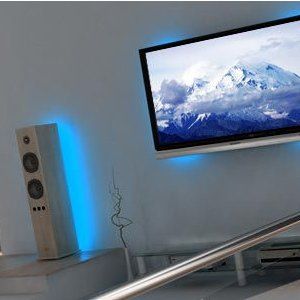We’ve made no secret of the fact that we love the Philips Ambilight technology and the impact it can add to an already impressively large screen.
Our quick take
The set-up and build of the Illuminaires is quite basic, and you'll need to be ok with sticking bits of foam at least semi-permanently to the back of your TV, but we were fairly impressed by the results.
If you've been wowed by the Philips Ambilight in the past and would love something similar on your current TV, this is a pretty good way of going about it.

Illuminaire PLX318 - 3.5 / 5
| FOR | AGAINST |
|---|---|
|
|
If you’ve got a decent sized HD TV but are devoid of such wonders you might be left thinking it’s something you’ll just have to live without.
Not so, say Illuminaire, who provide a home theater lighting system designed to supplement an LCD or plasma and create a similarly dynamic lighting effect.
The setup is actually rather simple; the box contains two LED tubes that project different intensities of red, green and blue light to allow for millions of unique colours. The PLX318 model contains two 24" light bars and is suitable for 32-60" screens, though lower models in the range are available for smaller sets.
The tubes are fixed to the back of your television in rather makeshift fashion using double-sized sticky pads, cable ties and small plastic attachments. It doesn't sound particularly high-end but does mean that the lights are pretty quick and easy to set-up. You'll then need to hook up a digital controller which contains four USB ports (allowing you to add up to two additional lights for other equipment) a power supply port and connection for the supplied remote control LED. These can also be attached to the back of the screen with sticky backed plastic, and if you get a little inventive with some cable tidies it's fairly easy to keep everything tucked out of sight.
You can adjust the intensity of the lights initially by twisting the tubes to change the direction of the LEDs. When you turn the thing on you'll see the lights fire up and can use the supplied remote control to cycle between colours manually, automatically, engage a "night mode" to adjust brightness and store up to seven favourites for quick access later. All of this works pretty well, but the remote is a bit unresponsive and quite flimsy so most people will probably want to teach the codes to an all-in-one.
Despite what appears to be a fairly basic setup we were initially quite impressed by the effect of the Illuminaire, which achieves quite similar results, at least in terms of the light spread and intensity, to an Ambilight.
Unfortunately the one big drawback here is that the colour of the light won’t change automatically to match what’s being shown on-screen, so you’ll probably end up spending far more time than you’d like fiddling about to find a colour you’re happy with, only to change your mind a few minutes later. That being said, there’s still a distinct "wow" factor to be had here, and while you might think £150 is quite a lot to pay when you unpack the thing and set it up, we think the overall impact is worth it.
To recap
If you’re a chronic "fiddler" you’ll probably spend hours tweaking the colours on the Illuminaire system, but we were impressed enough by the results to recommend it
